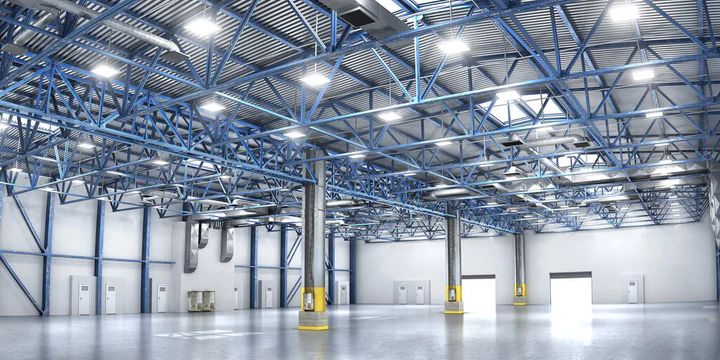Lighting in a warehouse is more than just making sure people can see. It impacts safety, productivity, energy costs, and even worker satisfaction. When you do it right—with good design, the right fixtures, and smart controls—you’ll see big savings and better operations. This guide walks you through everything you need to know about warehouse lighting and high bay lights.
Why Warehouse Lighting Matters
Warehouses often operate in demanding settings: high ceilings, lots of shelving, forklifts moving around, sometimes 24/7 operations. Good lighting is essential for:
-
Safety: Reducing slip, trip, collision risks; better visibility in aisles and around pallets.
-
Productivity & Accuracy: Clear lighting helps workers read labels, pick efficiently, and see hazards. Poor lighting slows work or causes mistakes.
-
Energy & Cost Control: The wrong lighting can cost a lot in energy and maintenance. LEDs and modern fixtures reduce those costs significantly.
-
Compliance & Employee Comfort: Ensuring that lighting meets industrial safety standards and helps reduce eye fatigue.
Many warehouse lighting issues arise from outdated lighting (HID or fluorescent) which have limitations like long warm-up times, poor lumen depreciation, and limited color temperature options.
Choosing the Best Light Source: HID, Fluorescent, or LED
HID (High Intensity Discharge)
-
Traditionally used. Examples include metal halide and high-pressure sodium.
-
Pros: Low initial cost; high lumen output.
-
Cons: Poor color rendering; warm-up/cool-down delays; frequent replacements; lumen depreciation; less flexibility in color temperature.
Fluorescent
-
More efficient than HID; offers more color temperature variety (2700-6500K).
-
Cons: Sensitive to extreme cold or heat; frequent cycles (on/off) reduce lifespan; glass tubes can break; lower durability.
LED
-
The most versatile and efficient for modern warehouse operations. According to Maverick LED, LEDs offer comparable or better lumen output with much lower energy usage, longer lifespan (up to ~100,000 hours), and minimal performance drop with frequent switching.
-
Other sources confirm these benefits: better light uniformity, fewer maintenance hassles, lower total cost of ownership.
Brightness, Color Temperature & Light Distribution
Brightness / Lumen Requirements
-
The required brightness depends on the warehouse tasks: general storage, picking, packaging, inspection.
-
Brightness is measured in lumens; older fixtures often specified by wattage, but LED spec is more helpful when you look at lumen output and lumens per watt (efficacy).
-
According to Top 5 Benefits of LED Warehouse Lighting (Litetronics), general warehouses and walkways may need ~100 lux; more demanding tasks or loading docks require 300-400 lux.
Color Temperature (CCT)
-
Cooler color temperatures (4000-5000K) are often preferred for warehouses. They help reduce eyestrain and improve visibility.
-
Warm temperatures are less common except in break areas or offices inside warehouse spaces.
Light Distribution / Beam Types
-
Light distribution types “Type I” (narrow, elongated) vs “Type V” (wide, circular or square) matter based on layout and shelving. For tall shelving rows: Type I; for open floor plans:
-
Beam angle and fixture optics need to be chosen to avoid glare, hotspots, and dark zones. Uniformity is key.
High Bay Lights: Types, Styles & Where to Use Them
High bay lights are the workhorses of large industrial spaces. A ceiling height of ~20 to 45 feet is typical.
Styles & Types
-
Round / UFO High Bays: Compact, round lights; good for general area lighting; often used in large, open warehouses.
-
Linear High Bays: Rectangular, long fixtures; good for aisles and zones needing elongated light spreads; more uniform lighting over rows of shelves.
-
Vapor-tight / enclosed high bays: For moist or dusty environments, or where exposure to water or chemicals may occur.
How to Pick
-
Match fixture type to ceiling height & layout. Higher ceilings often need higher lumen output and tighter beam angles to ensure light reaches the floor well.
-
Consider adjustable fixtures or those with selectable CCT / lumen settings. Some fixtures allow wattage or beam adjustments.
-
Factor in mounting options: suspension, pendant, chain, or hook mount depending on ceiling construction and maintenance access.
Layout, Mounting & Fixture Positioning
Even with good fixtures, improper layout can ruin lighting performance. Key factors:
-
Spacing: Too far → dark zones; too close → overlap, wasted light, glare. Use photometric layout planning.
-
Mounting Height: Determines how widely each fixture’s light spreads. Higher height requires higher output and narrower beam or optics to concentrate light. If height is lower, wider beam angles help avoid harsh brightness.
-
Ceiling and Wall Reflectance: Lighter colors bounce light, lifting overall illuminance; dark surfaces absorb light, requiring more fixtures. Lighter ceilings & walls can reduce the need for high lumen fixtures.
-
Avoiding Glare: Use diffusers, lenses, or shields. Position fixtures to minimize direct glare into worker zones or into equipment operators’ eyes.
Controls & Energy Efficiency Measures
Smart controls often cut energy usage significantly in warehouse lighting systems.
-
Occupancy / Vacancy Sensors: In zones or aisles with intermittent activity, these can dim or turn off lights when no motion is detected.
-
Daylight Harvesting: If your warehouse has skylights or windows, you can reduce the number of fixtures or dim parts of the system during daylight hours.
-
Dimming Controls: Many LED high bay light fixtures offer dimming or power selection to adapt to varying needs.
-
Zone Switching / Multiple Circuits: Separating lighting into zones allows parts of the warehouse to be lit only when needed.
Maintenance & Durability Considerations
Because warehouse lighting fixtures are often mounted high and in harsh conditions, durability and maintenance matter a lot.
-
Fixture lifespan: LEDs with 50,000 hours or more lifespan greatly reduce replacement frequency.
-
Ingress Protection (IP) ratings: Dust, moisture, sometimes chemicals — choose fixtures built to protect against these.
-
Heat Management: Though LEDs generate less heat than HID, proper heat sinking and air flow is needed to avoid reduction in lifespan. High ambient temps degrade LED output.
-
Easy Access for Maintenance: Fixtures designed with accessible components, robust mounting, and minimal hassle for replacement or cleaning.
ROI & Real-World Savings
Switching from older lighting to LED high bay systems delivers real savings.
-
Energy cost reductions: LED high bays often reduce energy usage by 40-60% compared to HID lights.
-
Lower maintenance and operating costs: Fewer replacements; less downtime & labor; fewer service calls.
-
Improved safety and fewer accidents: Better lighting reduces risk, which can reduce liability and insurance costs.
-
Long-term investment: Though initial cost is higher, the combined savings in energy + maintenance often pay back in 1-3 years depending on usage hours and electricity rates.
How to Plan an Upgrade or Retrofit
If your warehouse lighting is old, here’s how to plan an upgrade:
-
Audit current lighting: Measure current illuminance, count fixtures, record energy usage, note dark spots or problem areas.
-
Define goals: Safety, energy savings, uniformity, color temperature, compliance, etc.
-
Select fixtures: LED high bays (round or linear), vapor tight, etc. Choose quality brands with good warranties.
-
Design layout & spacing: Use lighting simulation or consultant help; decide on mounting heights, beam angles.
-
Incorporate controls: Sensors, dimming, daylight harvesting.
-
Plan for installation & safety: High ceilings may require lifts or special rigs. Factor those into costs.
-
Monitor & maintain: After installation, measure actual performance, adjust zones/control schedules, clean fixtures, inspect drivers.
Conclusion
Good warehouse lighting is an investment—it’s about more than just paying the lights to turn on. When done well with high bay lights, careful layout, smart controls, and quality fixtures, your warehouse becomes safer, more productive, and far less expensive to operate.
If you’re considering upgrading your warehouse lighting, keep in mind:
-
LEDs are generally the best long-term choice.
-
Match fixture type, beam distribution, lumen output, and CCT to your space’s layout and tasks.
-
Use controls and zoning to avoid wasting energy.
-
Prioritize durability and maintenance ease, especially in challenging environments.


